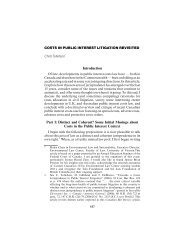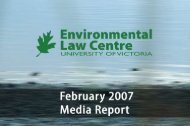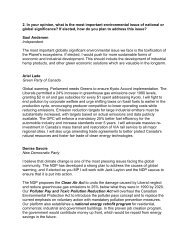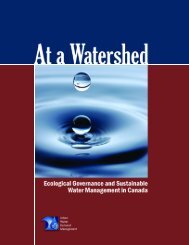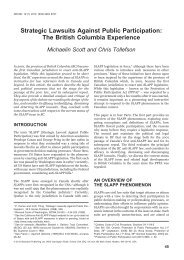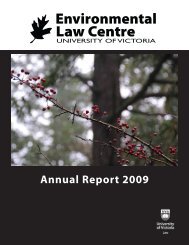Peeling back the Pavement - POLIS Water Sustainability Project
Peeling back the Pavement - POLIS Water Sustainability Project
Peeling back the Pavement - POLIS Water Sustainability Project
Create successful ePaper yourself
Turn your PDF publications into a flip-book with our unique Google optimized e-Paper software.
About <strong>the</strong> handbook: MOVING FORWARD BY PEELING BACK<br />
<strong>Peeling</strong> Back <strong>the</strong> <strong>Pavement</strong>: A Blueprint for Reinventing Rainwater Management in<br />
Canada’s Communities is a resource for decision makers, community leaders, and<br />
local government staff who want to take action to improve stormwater management.<br />
This handbook is not a technical how-to guidebook or manual for developing<br />
stormwater or watershed management plans. Instead, it makes <strong>the</strong> case—from<br />
ecological and financial perspectives—for a new approach to managing rainfall and<br />
snowmelt in Canada’s communities, and seeks to engage in a sophisticated discussion<br />
about rainwater governance.<br />
The purpose of this handbook is to empower communities to “peel <strong>back</strong> <strong>the</strong><br />
pavement” and manage rainwater in concert with natural systems. It outlines <strong>the</strong><br />
problems associated with <strong>the</strong> Stormwater City, and <strong>the</strong>n provides a blueprint for<br />
transitioning to <strong>the</strong> Rainwater City.<br />
The core focus of this handbook is on reducing <strong>the</strong> amount of impermeable<br />
surfaces in urban areas, repairing and upgrading broken drainage infrastructure,<br />
using rain as a resource, and integrating local land and water management on a<br />
watershed scale. With <strong>the</strong>se actions, communities can adopt a rainwater approach<br />
to managing wet wea<strong>the</strong>r.<br />
Getting <strong>the</strong>re will require<br />
“How can we move beyond<br />
a transformation in practice, current best practices, use rain<br />
priorities, and how and by whom as a resource, and prevent <strong>the</strong><br />
key decisions are made. The approach<br />
outlined in this hand-<br />
problem of runoff altoge<strong>the</strong>r?”<br />
book is not only better for ecosystems, it is also less expensive than conventional<br />
management techniques (even in <strong>the</strong> short term and most certainly in <strong>the</strong> long<br />
term) and <strong>the</strong>refore sustainable.<br />
Over <strong>the</strong> past several decades, numerous reports have documented and catalogued<br />
<strong>the</strong> damage caused by urban stormwater runoff and offered detailed<br />
prescriptions to improve its management (see Appendix). Many communities<br />
across Canada have attempted to improve upon conventional stormwater<br />
management by introducing additional measures that improve <strong>the</strong> quality and<br />
reduce <strong>the</strong> volume of runoff. While some jurisdictions are ahead of o<strong>the</strong>rs, a<br />
complete integration of land- and water-use decisions has yet to be realized.<br />
The questions of why poor stormwater decisions continue to be made in many<br />
places and why positive alternative management practices are rarely fully<br />
employed or widely implemented (despite being increasingly recognized as a<br />
viable solution) have not, to date, been effectively addressed. This handbook<br />
goes beyond <strong>the</strong> question of “What are <strong>the</strong> problems with stormwater runoff?”<br />
by asking “How can we move beyond current best practices, use rain as a<br />
resource, and prevent <strong>the</strong> problem of runoff altoge<strong>the</strong>r?”<br />
3



